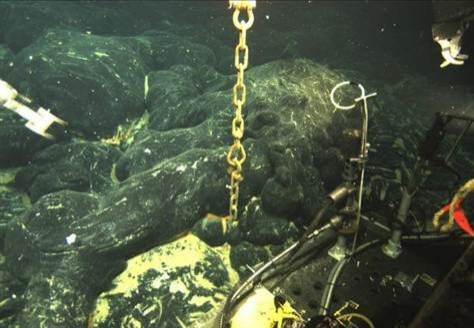Eruption of Undersea Volcano Successfully Predicted for First Time

Scientists have discovered that the Axial Seamount, one of the world's most heavily studied undersea volcanoes, has erupted 250 miles off the coast of Oregon.
This came as a great surprise to the team of scientists who had studied the submerged volcano:
"At first we were really confused, and thought we were in the wrong place," Bill Chadwick, a geologist with Oregon State University who lead the study, told Fox12 Oregon. "Finally we figured out we were in the right place but the whole seafloor had changed, and that's why we couldn't recognize anything. All of a sudden it hit us that, wow, there had been an eruption. So it was very exciting."
In the eruption, which scientists say occurred in early April, the undersea volcano spewed a layer of lava more than 12 feet (4 meters) thick in places. It also opened up deep vents that continue to belch hot water and microbes from deep inside the earth into the ocean.
Axial Volcano rises 3,000 feet above the seafloor, and is the most active of a string of volcanoes along the Juan de Fuca Ridge, a plate boundary where the seafloor is slowly pulling apart.
While scientists were surprised to find the ocean floor transformed from the eruption, it actually coincided with their earlier predictions.
Up until now, predicting eruption cycles for undersea volcanoes has been a mix of science and best guesses. What makes this study so intriguing, is that scientists actually forecast the eruption five years ago, making this the first ever successful forecast of an undersea volcano.
"Their prediction was that based on the 15 centimeters per year inflation rate, they would hit that point where it would be ready to erupt before the year 2014," David Butterfield, an oceanographer working on the project, explained to MyNorthwest. "The theory was that when it re-inflated back to that same level, refilling the magma chamber with magma, then it should be ready to re-erupt."
When the eruption occurred sometime in April, it confirmed their predictions.
So why did it come as such a surprise that the volcano had erupted?
Well, after the 1998 blast, scientists set a time frame for the next eruption between 2011 and 2014. Information on subsea volcanoes is still very sparse and though technology has improved, predicting their eruption cycles is still a tough call.
When they went to retrieve the instruments they'd left behind to monitor the peak a year earlier, they were pleased to find that the eruption occurred on the earlier side of their prediction.
The eruption had a unique effect on the biological makeup of the surrounding water. Chadwick explained to Science Daily:
"When eruptions like this occur, a huge amount of heat comes out of the seafloor, the chemistry of seafloor hot springs is changed, and pre-existing vent biological communities are destroyed and new ones form. Some species are only found right after eruptions, so it is a unique opportunity to study them. So far, it is hard to tell the full scope of the eruption because we discovered it near the end of the expedition, but it looks like it might be at least three times bigger than the 1998 eruption."
Chadwick, along with Scott Nooner of Columbia University, has monitored Axial Seamount for over a decade. Together, they published a paper in the Journal of Volcanology and Geothermal Research back in 2006 stating their predictions.
Largely due to their work, Axial Seamount is now the only volcano on the seafloor whose surface deformation has been continuously monitored for an entire eruption cycle. Scientists are still working to pinpoint how seafloor volcanoes differ from their terrestrial counterparts.
The July expedition was sponsored by the Woods Hole Oceanographic Institution.
© Copyright IBTimes 2024. All rights reserved.








